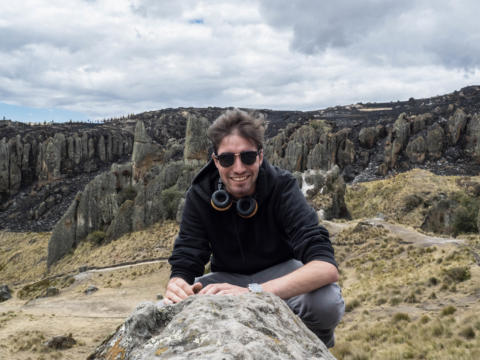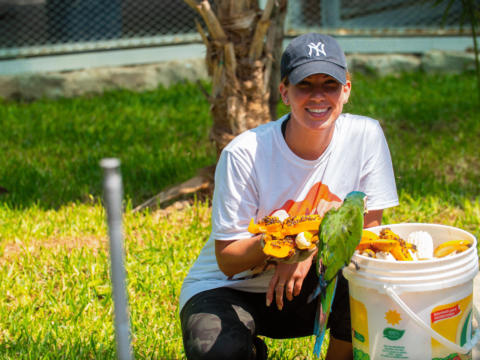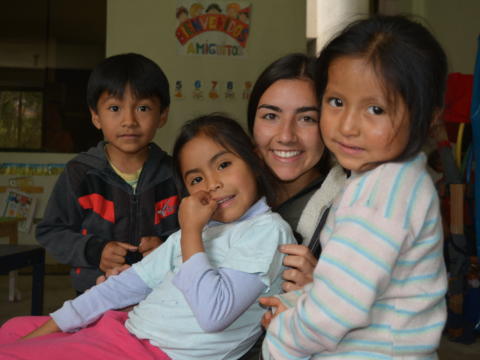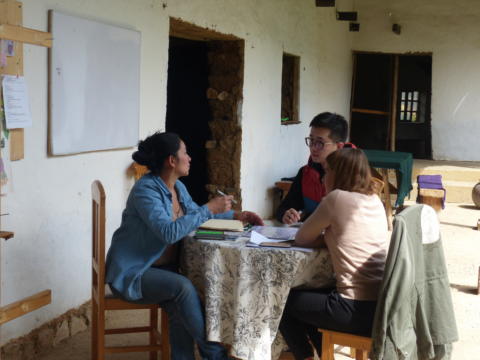Only 480€ per week!
Spanish Language Classes
Chiclayo - Peru
Our classes are a great way to learn Spanish and immerse yourself in the local culture, lifestyle and cuisine of Peru. Learning a language has never been so fun!
This program gives you the chance to bond and participate with your fellow classmates in a positive learning environment designed to give you individual help from our teachers. These sessions will improve your Spanish allowing you to easily spend your time in local Peru.
Program Description
Learn the Spanish quickly and effectively while experiencing the Peruvian culture, cuisine and lifestyle!
In our 20 hour per week Spanish course, you will be learning in a group made up of no more than six students. This ensures that you get plenty of time and attention from your teacher, while giving you a fun and interactive way to learn Spanish and bond with your fellow classmates.
If this is your first time attending our classes, you will be required to take a placement exam in the morning to ensure you are placed in the class that suits your level the most. The length of the time needed to complete the test will depend entirely on your Spanish skills – the longer, the better. After one of our teachers has graded your test, you will be introduced to your class!
Our teachers are local Peruvian teachers who have a strong grasp of the language and a unique teaching style that can be flexible. Our teachers speak little English for the reason this enhances the learning experience and immersion of learning Spanish.
Aims & Objectives
- Ensure that you learn Spanish as fast as possible
- while experiencing the Peruvian culture, cuisine and lifestyle!
Schedule
Monday to Friday
You will have four hours of class a day either in the morning or after lunch. Together, they will sum up to about 20 hours per week. The day may look like:
- Breakfast
- Spanish grammar, vocabulary or conversation class
- Lunch Break
- Spanish conversation class
- Dinner
- Independent learning or free time
Note: This schedule can be changed and/or amended depending on weather conditions, local conditions and unforeseen circumstances.
Participant Criteria & Requirements
Standard Requirements
Minimum age: –
Maximum age: –
Minimum English level: Basic
CRB required: On Signup
Passport copy required: No
Resume copy required: No
Required qualification: None
Additional Requirements
There are no further requirements for this program.
Additional Equipment
Required
- Notebook and pen
Optional
- Recording device
- Spanish – English Dictionary
Location
Our center in Peru is located in the North of Peru, in the main city of Chiclayo. You can easily reach Chiclayo, Peru’s fourth biggest city, by public transport which is cheap and frequent. Chiclayo offers shopping centers, a cinema, a nightlife and from here you can visit the famous museum of the lord of sipan, the tucume pyramids and the dry forest of algarrobos. It is also a traffic hub in north Peru. This makes it easy to travel on the weekends or after your program.
There are plenty of small restaurants or shops around the area. There is an active surfing community and it is easy to make local friends.
About the Accommodation
Our accommodation is gender separate rooms, shared homestay style. It is a very typical Chiclayo neighborhood and our local host is keen and motivated offering local family-style interactions and cultural exchanges.
Food Arrangements
The food will be typically Peruvian meaning lots of corn, beans, rice, chilli peppers, potatoes, wheat, and other grain, all very vegetarian friendly. Keep in mind that some local dishes may be spicy!
Facilities
Supermarket: Located 5-10 minutes walking distance from the residence or host family
ATM: There are several ones in the supermarket.
Laundry: We provide laundry service nearby at a cheap cost.
Market: There is a small market in about 2-15 minutes walking distance from the residence or host family. Every morning you can get fresh fruits, fish meat etc there.
Restaurants: There are plenty of small restaurants within walking distance. Especially along menu places where you can find lots of fresh fish dishes, deserts and local refreshments.
Sauna & Spa: There is a Spa in Chiclayo that you can reach by public transport or taxi (ca. 4 USD) within about 30 minutes. Sauna and massage (30 min) cost about S/. 20-30 each.
Activities & Events
No scheduled activities outside the program.
Sights & Surroundings
In and around Chiclayo there is an array of places and sights that our participants usually visit on weekends that lets you explore Peru besides the mainstream tourist routes. Even if you stay in Peru for a few months, you won’t run out of astonishing places to visit!
Short distance (max 1.5 hours distance)
-
Mercado Modelo: Famous witch doctor’s market
Mercado Modelo is a huge market in the center of Chiclayo not only offers tons of fresh fruits and vegetables, meat, fish and other kinds of food you might not have seen before as well as services like tailors and shoemakers, but it also hosts the famous witch doctors market. There you find shark jaws, deer legs, snakeskins, potions, scents and amulets. There are heaps of dried mountain herbs and San Pedro cacti, which shamans use to produce a hallucinogenic drink.
-
Bosque de Pomac: Peru’s oldest tree in World’s largest dry forest
Visit the world’s largest dry forest just north of Chiclayo. Besides Peru’s oldest tree it also hides pyramids of the Sican culture. The attentive visitor can easily spot left overs of antique ceramics or even bones along the walkways. Combine the visit with a horseback ride to get the most out of it.
-
Tumbas Reales – Senor de Sipan: Best Museum in Latin America
The museum in Lambayeque, just a bit more than an hour from our center, is considered the best museum in Latin America because it exhibits one of the most important gold treasure discoveries in ancient Peru and the world. You’ll view amazing artifacts of gold, silver, precious stones and other metals. You should take a guide to fully understand all the exhibits. Go in a group and you can split the cost of the guide.
Full day trips (max 3.5 hours distance)
-
Tucume
The “valley of the pyramids”, discovered just a few years ago, once formed the world’s largest pyramid complex. Restoration started a few years ago and a new and extensive museum just opened its doors.
-
Huaca Rajada
Some of the world’s most extraordinary tombs, place of discovery of the “Lord of Sipan'', also known as the "King Tutankamon of the Americas". Most of the treasures found the tombs are now displayed in the museum Tumbas Reales, but still the site is definitely worth a visit.
-
Huaca del Sol & Huaca de la Luna
Well known pyramids of the Moche culture, hosting Peru’s best preserved murals. One used to be an administrative center, the other one a religious complex.
While you can visit the pyramids in a single day, getting back to Chiclayo by night, we recommend combining the visit with a tour through Chan Chan, staying overnight at the popular beach of Huanchaco. Take the chance to also visit beautiful colonial Trujillo.
-
Chan Chan: World’s largest adobe city
Chan Chan not only used to be America’s biggest city, but also was and still is the world’s largest city built of adobe – sun dried mud-bricks – with walls as high as 12 meters, being home for about 60.000 inhabitants. Since it was conquered by the Inkas, it’s extension declined to about 20 square kilometers, of which only a few parts are actively restored. As this impressive place is endangered by the more and more frequently occurring El Niño storms, consider visiting it soon.
-
Pimentel
At this seaside tranquil town where you can sunbathe, visit beautiful sandy beaches and engage in surfing till your heart's content.
Weekend trips (more than 3 hours distance)
-
Cajamarca
Famous for its colorful carnival and as the place where the Inca Empire came to and end, Cajamarca and it’s surroundings keep you busy for a whole weekend and invite you to come back. Visit the old town, Ventanillas de Otuzco – pre-inca grave caves carved into a vertical rock – or just soak in the hot thermal baths “Baños del Inca”.
-
Puerto Chicama
Between Chiclayo and Trujillo there is the unflashy fishermen outpost Puerto Chicama. But not only have there been found surfboards dating back to the 1930s or even earlier, but it also has long been a well-protected secret that locals managed to surf for about 2.2 kilometers on a single wave, which makes it the world’s longest wave. It’s not as far from Chiclayo but still you will want to spend an entire weekend there.
-
Trujillo
This is a traditional old-style city turned modern. It is a very unique setting with a blend of colonial buildings to pre-incan ruins and prestigious sites. Trujillo also boasts of the Capital of the traditional national dance (marinera). If you ever make it to this destination, the most iconic historical site to visit is the pre-incan civilization – Chanchan.
Transportation
From this location we provide free transport to your next program at the following location(s):
- Cajamarca
- Lambayeque (Chiclayo)
Quick Facts
Name: Republic of Peru
Population: 31 million
Capital: Lima
Language: Spanish (Quechua, Aymara)
Currency: Nuevo Sol (PEN)
Time zone: PET (UTC -5)
Country Information
Peru is the third largest country in South America; a country known for its incredible cultural heritage such as the renowned Machu Picchu and the remains of the Inca Empire. Although the Incas are the most famous ones, there are other manifestations of pre-Columbian cultures and unexplored archaeological sites which can be located in the North of Peru. This magnificent land composed of a variety of landscapes, climates and biodiversity, is visited by tourists from all over the world.
In Peru, it is possible to enjoy a range of activities from surfing in the Northern beaches to hiking in the Andes Cordillera, from trekking in the humid and hot Amazon rainforest to visiting cultural sites, excellent museums, and enjoying traditional dishes. Peruvian people are very friendly, warm, and ready to help or to introduce you to their customs. You will find in these regions a great diversity of ethnic groups, festivities, handcraft, and gastronomy.
Peru is a country of contrasts where the crazy traffic is surpassed by the majesty of mountain ranges. You will find cities peaking at altitudes of more than 6700 meters, infinite beaches with beautiful sunsets, the magically diverse landscape of the tropical rainforest and let’s not forget about the llamas.
Climate
Despite being near the Equator, the presence of different regions of the Andes Cordillera and the arid coast along with the effects of the cold Humboldt Stream induce highly distinct weather. The climate in Peru consists in three main regions: Costa, Sierra, Selva (the coast, the mountains and the jungle).
Costa
The coast of Peru represents 10% of the whole surface of the country. Within this part of the coast, the north has a semi-tropical climate. Because of the Humboldt Stream, the temperatures are not that hot for a desert. The temperature is around 24°C all year long. The Southern region, including the central coast and the south, has a subtropical climate. The temperatures range from 15°C during the winter to 26°C during the summer. Summer is from December to March.
Sierra
Alongside the Andes Cordillera, the winter is dry and the summer rainy. The annual temperatures fluctuate from 11 to 16°C but with wide differences from one site to another because of the different altitudes. Therefore, it is better to come during the winter from May to September during the dry season and enjoy the Costa during the summer.
Selva
This is the Amazon region of Peru that represents 60% of the Peruvian surface. The climate is humid, hot, with rainfall all year long and especially during the rainy season from January to April. During the dry season, it usually rains once per week with temperatures fluctuating around 30°C.
In any case, it is preferable to have 3 kinds of outfits for cold, hot and rainy weather. This beautiful country has different climate zones since it has deserts, mountains and Amazon rainforest.
Culture
The Peruvian culture is widely known for its Inca Empire and the ruins of Machu Picchu. However, Peru includes a lot of other different cultures that are lesser known. Before being colonized in the 16th century by Spain, and before the Inca Empire, other cultures were already very organized, structured economically and politically. This is particularly the case of the Chavín and Mochica cultures which date from 1800-200 BC. Hidden archaeological treasures of these cultures are present in the north of Peru. The Lambayeque Region is the biggest hotspot of unexplored archaeological places in the world while the south of Peru is the most touristic region with Cusco, Machu Picchu and Arequipa.
The country recognizes the practice of other religions. Nevertheless, since its independence from Spain in 1821, Peru remains mainly catholic at 80%. Therefore a lot of churches are present in the country. Inspired from the colonial style, they often constitute the sights to see, along with buildings from the same era in big cities such as Chiclayo, Piura, Trujillo, Arequipa, and Lima. Even with Catholicism as the predominant religion, several events and festivities in Peru refer directly to Inca celebrations and ceremonies. Peru is a colourful country, as evidenced by the traditional fabric you can find in the handcraft markets.
The city of Cajamarca is renowned for its carnival where paint battles take place every year. If you are out and about on those days, expect to be targeted with paint and water during the celebration. Peru is also a country of dances. The national dance is the Marinera and it is frequently practiced along the coast, while traditional tribal dances can be found in jungle areas.
Nowadays, Peru is a multicultural country due in part to the colonialism period, but also because of the different migration phases. The indigenous population represents 45% of the population while the rest is a mixture of different ascendances. A third of the population is Metis and has Spanish origins. Then there is a melting pot of European, African and also Asiatic people. The indigenous are more present in the Selva while the rest of the country is mixed with the other ethnicities. Also, in the jungle and mountains, it is more frequent to see people wearing traditional clothes such as the poncho, the hat and the long skirt for women. While the Amazon represents 60% of the Peruvian surface, it is the least densely populated region of the country. Therefore, it holds lots of beautiful unseen areas and uninhabited parts, which remain untouched by humans.
Gastronomy
Another important sector in Peru is the fruit production. Peru is a land of fruit trees, like Mango and Cherimoya, which are very tasty.
Peruvian gastronomy is award winning! Among its specialities are the Ceviche, which is made with raw fish, seasoned with lemon and spices, the Anticuchos made with beef heart, the Chicha Morada, a national drink made with purple corn, and the national alcohol: Pisco.
Peruvian gastronomy is considered to be one of the most diversified and famous in South America. Very often, dishes include rice; this may be in part because of the Chinese migration influence. Since then, “Chifa” in Peru has been used in reference to Chinese cooking.
Transportation
Public transportation in Peru is very easy and the travel costs are low. The traffic may be crazy in Lima and in general, but for long distances, the most common means of transportation is by bus and it is very safe.
Perú shares borders with Brazil, Colombia, Chile, Bolivia and Ecuador. This is great for travelers because it is very easy to combine different destinations. One such option is Peru and Ecuador, which has one of the most biodiverse landscapes in the world.





